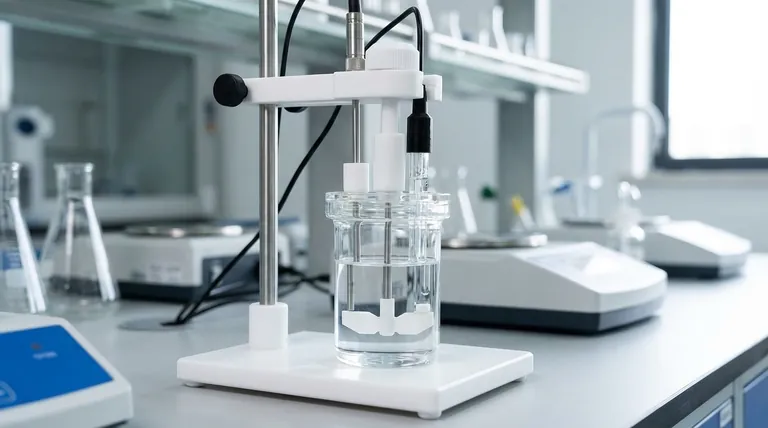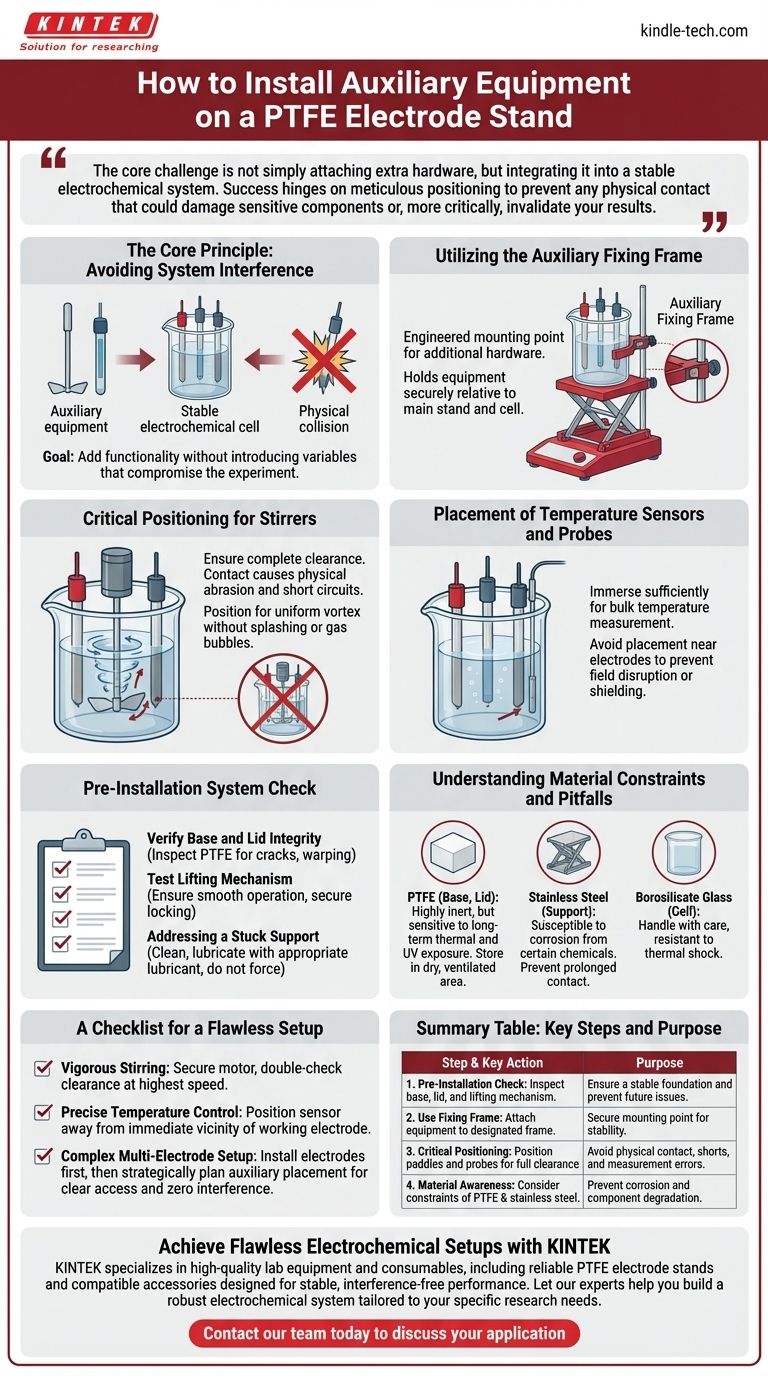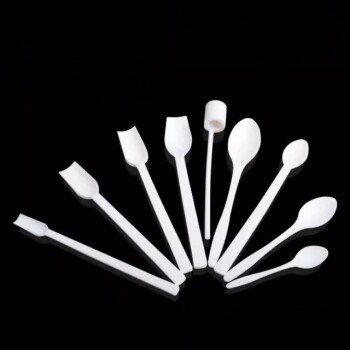To install auxiliary equipment on a PTFE electrode stand, you must use the designated auxiliary fixing frame. The critical step is to position the equipment—such as a stirrer or temperature sensor—so that it operates without physically interfering with the electrolytic cell or the electrodes themselves. Proper placement is essential to prevent damage and ensure the integrity of your experiment.
The core challenge is not simply attaching extra hardware, but integrating it into a stable electrochemical system. Success hinges on meticulous positioning to prevent any physical contact that could damage sensitive components or, more critically, invalidate your results.

The Core Principle: Avoiding System Interference
Proper setup is foundational to reliable electrochemical measurements. The goal is to add functionality without introducing variables that compromise the experiment, such as physical instability, electrical shorts, or damage to electrode surfaces.
Utilizing the Auxiliary Fixing Frame
The auxiliary fixing frame is the engineered mounting point for additional hardware. It is designed to hold equipment securely in place relative to the main stand and the electrolytic cell.
Critical Positioning for Stirrers
When installing a mechanical stirrer, ensure the stirring paddle or bar has complete clearance. Contact with an electrode can cause physical abrasion, altering its electrochemically active surface area and potentially causing a short circuit.
The paddle should also be positioned to create a uniform vortex in the solution without splashing the electrolyte or creating gas bubbles that could cling to electrode surfaces.
Placement of Temperature Sensors and Probes
A temperature sensor should be immersed sufficiently to measure the bulk temperature of the solution accurately. However, it should not be placed so close to the working or reference electrode that it disrupts the electrochemical field or shields the electrode surface.
Pre-Installation System Check
Before mounting any equipment, a brief inspection of the stand itself will prevent future problems and ensure a stable foundation for your cell.
Verify Base and Lid Integrity
Inspect the PTFE base for any cracks, warping, or chemical damage. A stable, level base is non-negotiable for safety and measurement consistency. Ensure the PTFE lid fits securely on the glass cell body.
Test the Lifting Mechanism
Confirm that the stainless steel lifting support slides smoothly without sticking. The adjustment knobs should lock the position firmly without any slippage, which is crucial for setting a precise and repeatable electrode immersion depth.
Addressing a Stuck Support
If the support mechanism is stuck, do not force it. Clean the stainless steel rod of any residue or impurities. After cleaning, apply a small amount of appropriate lubricant to ensure smooth operation.
Understanding Material Constraints and Pitfalls
Knowing the materials of your stand—typically a PTFE base and lid, a stainless steel support, and a high borosilicate glass cell—informs its proper handling and limitations.
Chemical Compatibility
While PTFE is highly inert, the stainless steel support is susceptible to corrosion from certain chemicals. Prevent prolonged contact with corrosive substances to maintain the stand's structural integrity.
Thermal and UV Sensitivity
Always store the stand in a dry, ventilated area away from direct sunlight or high-temperature environments. While robust, long-term exposure can degrade components or cause minor deformation, compromising the precise alignment required for electrochemical work.
A Checklist for a Flawless Setup
Use these guidelines to tailor your setup to your specific experimental needs.
- If your experiment requires vigorous stirring: Secure the stirrer motor firmly and double-check the clearance between the paddle and all surfaces (electrodes and glass walls) at its highest operational speed.
- If you need precise temperature control: Position the sensor to measure the bulk solution, keeping it away from the immediate vicinity of the working electrode to avoid recording localized heating effects.
- If you are using a complex multi-electrode setup: Install all electrodes first, then strategically plan the placement of auxiliary equipment to ensure clear access and zero interference.
A methodical and careful approach to your experimental setup is the first step toward achieving reliable and repeatable results.
Summary Table:
| Step | Key Action | Purpose |
|---|---|---|
| 1. Pre-Installation Check | Inspect base, lid, and lifting mechanism. | Ensure a stable foundation and prevent future issues. |
| 2. Use Fixing Frame | Attach equipment to the designated auxiliary frame. | Secure mounting point for stability. |
| 3. Critical Positioning | Position stirrer paddles and probes for full clearance. | Avoid physical contact, shorts, and measurement errors. |
| 4. Material Awareness | Consider chemical, thermal, and UV constraints of PTFE & stainless steel. | Prevent corrosion and component degradation. |
Achieve Flawless Electrochemical Setups with KINTEK
Properly integrating auxiliary equipment is crucial for the integrity of your experiments. KINTEK specializes in high-quality lab equipment and consumables, including reliable PTFE electrode stands and compatible accessories designed for stable, interference-free performance.
Let our experts help you build a robust electrochemical system tailored to your specific research needs.
Contact our team today to discuss your application and ensure reliable, repeatable results.
Visual Guide

Related Products
- Sample Support Body for Electrochemical Tests
- Platinum Sheet Electrode for Laboratory and Industrial Applications
- Electrolytic Electrochemical Cell for Coating Evaluation
- H-Type Double-Layer Optical Electrolytic Electrochemical Cell with Water Bath
- Reference Electrode Calomel Silver Chloride Mercury Sulfate for Laboratory Use
People Also Ask
- How should an electrode holder be cleaned as part of regular maintenance? Ensure Reliable Electrochemical Measurements
- What are the factors affecting sample size requirements? Master the Trade-Offs for Credible Research
- What materials are typically used for the components of an electrode holder? Select the Right Materials for Accurate Results
- What are the factors that affect sample size? Optimize Your Study's Power and Precision
- What are the steps for post-experiment procedures after using the cell with a conventional aqueous solution? Ensure Accuracy and Reproducibility



















